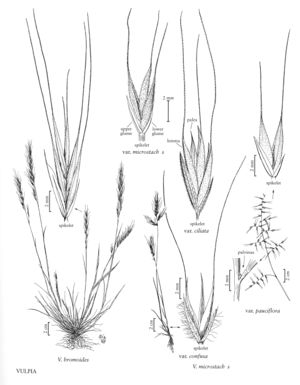Difference between revisions of "Vulpia bromoides"
FNA>Volume Importer |
FNA>Volume Importer |
||
| Line 26: | Line 26: | ||
-->{{Treatment/Body | -->{{Treatment/Body | ||
|distribution=Wash.;Del.;Pacific Islands (Hawaii);Fla.;Puerto Rico;N.Mex.;Tex.;La.;Idaho;Oreg.;N.C.;Tenn.;N.Y.;Nev.;Va.;Calif.;Ala.;Ark.;Ga.;Maine;Okla.;S.C.;Ill.;Ariz.;Mass.;Ohio;Utah;Mo.;B.C.;N.W.T.;Mont.;Ky. | |distribution=Wash.;Del.;Pacific Islands (Hawaii);Fla.;Puerto Rico;N.Mex.;Tex.;La.;Idaho;Oreg.;N.C.;Tenn.;N.Y.;Nev.;Va.;Calif.;Ala.;Ark.;Ga.;Maine;Okla.;S.C.;Ill.;Ariz.;Mass.;Ohio;Utah;Mo.;B.C.;N.W.T.;Mont.;Ky. | ||
| − | |discussion=<p | + | |discussion=<p>Vulpia bromoides is a common European species that grows in wet to dry, open habitats. It is adventive and naturalized in North and South America. In North America, it is most common on the west coast, where it grows from British Columbia to northern Baja California; it occurs sparingly in other regions.</p> |
|tables= | |tables= | ||
|references= | |references= | ||
| Line 42: | Line 42: | ||
|basionyms= | |basionyms= | ||
|family=Poaceae | |family=Poaceae | ||
| + | |illustrator=Linda A. Vorobik and Hana Pazdírková | ||
|distribution=Wash.;Del.;Pacific Islands (Hawaii);Fla.;Puerto Rico;N.Mex.;Tex.;La.;Idaho;Oreg.;N.C.;Tenn.;N.Y.;Nev.;Va.;Calif.;Ala.;Ark.;Ga.;Maine;Okla.;S.C.;Ill.;Ariz.;Mass.;Ohio;Utah;Mo.;B.C.;N.W.T.;Mont.;Ky. | |distribution=Wash.;Del.;Pacific Islands (Hawaii);Fla.;Puerto Rico;N.Mex.;Tex.;La.;Idaho;Oreg.;N.C.;Tenn.;N.Y.;Nev.;Va.;Calif.;Ala.;Ark.;Ga.;Maine;Okla.;S.C.;Ill.;Ariz.;Mass.;Ohio;Utah;Mo.;B.C.;N.W.T.;Mont.;Ky. | ||
|reference=None | |reference=None | ||
| Line 47: | Line 48: | ||
|publication year= | |publication year= | ||
|special status= | |special status= | ||
| − | |source xml=https:// | + | |source xml=https://bibilujan@bitbucket.org/aafc-mbb/fna-data-curation.git/src/314eb390f968962f596ae85f506b4b3db8683b1b/coarse_grained_fna_xml/V24/V24_644.xml |
|subfamily=Poaceae subfam. Pooideae | |subfamily=Poaceae subfam. Pooideae | ||
|tribe=Poaceae tribe Poeae | |tribe=Poaceae tribe Poeae | ||
Revision as of 16:08, 30 October 2019
Culms 5-50 cm, solitary or loosely tufted, erect or decumbent, smooth, scabridulous, or puberulent, unbranched distally. Sheaths glabrous or puberulent; ligules to 0.5(1) mm; blades usually 2-10 cm long, 0.5-2.5 mm wide, rolled or flat, glabrous or puberulent. Panicles 1.5-15 cm long, 0.5-3 cm wide, conspicuously exserted, with 1 branch per node; branches usually appressed to erect at maturity, without axillary pulvini; pedicels flattened, sometimes clavate distally. Spikelets 5-10 mm, with 4-8 florets, not closely imbricate; rachilla internodes 0.6-1.1 mm. Lower glumes 3.5-5 mm, 1/2 - 4/5 the length of the upper glumes; upper glumes 4.5-9.5 mm, midveins scabrous distally; lemmas 4-8 mm, 5-veined, scabrous distally, apices entire, awns of the lowermost lemma in each spikelet 2-13 mm; paleas 4-6.3 mm, equaling or shorter than the lemmas, minutely bifid; anthers 0.4-0.6(1.5) mm. Caryopses 3.5-5 mm. 2n = 14.
Distribution
Wash., Del., Pacific Islands (Hawaii), Fla., Puerto Rico, N.Mex., Tex., La., Idaho, Oreg., N.C., Tenn., N.Y., Nev., Va., Calif., Ala., Ark., Ga., Maine, Okla., S.C., Ill., Ariz., Mass., Ohio, Utah, Mo., B.C., N.W.T., Mont., Ky.
Discussion
Vulpia bromoides is a common European species that grows in wet to dry, open habitats. It is adventive and naturalized in North and South America. In North America, it is most common on the west coast, where it grows from British Columbia to northern Baja California; it occurs sparingly in other regions.
Selected References
None.
